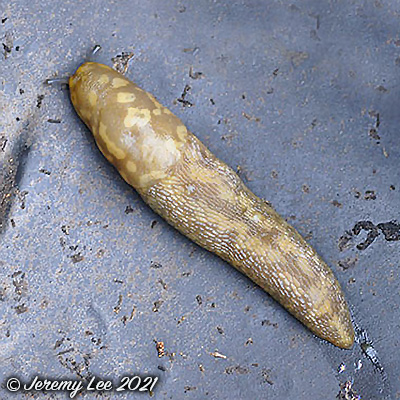
 |
|
Scientific Classifications explained » Amphibians » Ants » Aphids » Bees » Beetles » Birds » Bugs » Butterflies » Caterpillars » Damselflies » Dragonflies » Earwigs » Flies » Frog/Leafhoppers » Fungi » Galls » Grasshoppers » Harvestmen » Hoverflies » Lacewings » Ladybirds » Leaf Mines » Lichens » Mammals » Millipedes » Mosses » Moths » Sawflies » Slugs » Snails » Spiders » Trees » Wasps » Wild Flowers » Woodlice |
UK Nature > Slugs > Limacus flavus

Scientific Name: Limacus flavus Common Name: Yellow Cellar Slug Limacus flavus, or the Yellow Cellar Slug as it is commonly known, can grow up to 10 cm in length. The body is marbled and mottled in an olive-yellow colour. Its tentacles are blue. It has a central yellow line along the keel which extends from the tail to around half the body length, though may be broken into dashes. It is common and widespread in England, Wales and Ireland. It is mostly associated with houses and gardens - being known to venture indoors especially cellars after dark. Feeds mostly on fungi, decaying matter and vegetables, especially on compost heaps, but also feeds voraciously on seedlings and vegetables so where it does occur on agriculture and horticulture land it can do serious damage. |
|

https://www.uknature.co.uk is a website dedicated to showing the immense diversity of UK nature and wildlife. Our vast range of habitats, from lowland arable to snow covered mountains, from storm-ravaged coastlines to peaceful inland freshwater lakes and rivers, from dry, sandy heaths to deciduous and coniferous forests, all these habitats contribute to the abundance of UK nature. We have wild birds in huge numbers either residing or visiting our shores (597 recorded species as at July 2013) and we must also not forget the humble back garden with its grass lawns, flower beds filled with nectar rich flowers, shrubs and trees, all designed to attract huge numbers of insects such as bees, moths, butterflies and hoverflies; and finally the small ponds which provide safe havens for frogs, toads, newts and even slow worms and grass snakes. www.uknature.co.uk is the showcase for my personal passion, photographing uknature in all its glory. I sincerely hope you all enjoy the fruits of my labours. This site and all images contained therein is © Jeremy Lee 2004 - 2021. All Rights Reserved. Site design by Jeremy Lee. Site development & IT Support by Stuart Lee. |